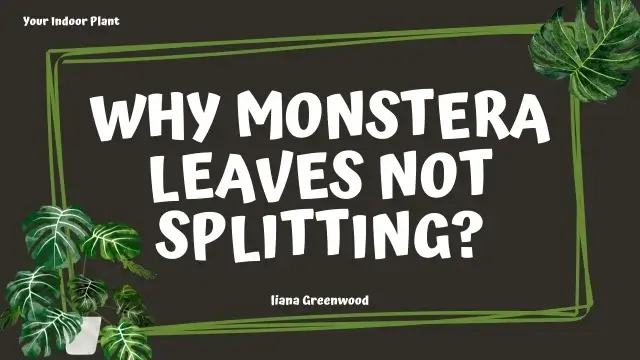Why Monstera Leaves Aren’t Splitting (And How to Fix It)

Monstera leaves don’t split mainly because the plant is too young, lacks bright indirect light, isn’t getting enough humidity or nutrients, or is root-bound. Creating optimal care conditions and allowing time for growth will encourage natural leaf fenestration.
Introduction
🌿 Brief Overview of Monstera & Their Iconic Split Leaves
Monstera plants, especially the popular Monstera deliciosa, are tropical stunners known for their dramatic, holey leaves. These natural openings, called fenestrations, give Monstera its unmistakable jungle vibe.
Why Split Leaves Matter to Plant Owners
To many plant parents, split leaves are a badge of plant health and care success. Seeing whole leaves may cause concern, especially when searching things like “why aren’t my Monstera leaves splitting” or “do all Monstera leaves split”.
Quick Reassurance: It’s Common for Monstera Leaves Not to Split
Relax—it’s often totally normal. Many Monsteras don’t split in the first year or even two. Some may never split if conditions aren’t right or if it’s a naturally unfenestrated variety.
What Are Split Leaves (Fenestrations) and Why Do They Occur?
Explanation of Fenestrations
Fenestrations are holes or deep cuts that form as the Monstera matures. They’re not damage or tears—they’re intentional design features of the plant.
Natural Purpose of Leaf Splits in Monstera Plants
Scientists believe fenestrations allow light to pass to lower leaves and help rain and wind move through the plant without breaking the leaves [1][2]. This adaptive trait helps Monsteras survive in dense rainforests.
The Role of Light, Water, and Fertilizer in Monstera Leaf Splitting
For Monstera enthusiasts aiming for dramatic, split leaves, mastering the interplay of light, water, and fertilizer is essential. Each factor directly influences the plant’s ability to produce those iconic fenestrations, and fine-tuning your care can make all the difference.
Light: The Critical Driver of Fenestration
Monsteras evolved in the dappled sunlight of tropical forests, where bright but indirect light fuels their growth. Adequate light is the single most important factor for leaf splitting. Without enough energy from light, Monsteras prioritize survival over producing large, fenestrated leaves.
Best practices:
- Provide bright, indirect sunlight—ideally 1,000–2,500 foot-candles (10,000–27,000 lux).
- Place near an east or south-facing window with sheer curtains to filter harsh rays.
- Use grow lights for 12–14 hours daily if natural light is insufficient, especially in winter.
- Watch for pale, leggy growth or small, solid leaves—these are signs your Monstera needs more light.
Water: Ensuring Steady Growth and Healthy Leaves
Consistent moisture supports cell expansion and nutrient transport, both necessary for developing split leaves. Both underwatering and overwatering can stress your Monstera and hinder fenestration.
Best practices:
- Water when the top 1–2 inches (2.5–5 cm) of soil are dry. Use a moisture meter for accuracy.
- Always water thoroughly until excess drains out—this prevents salt buildup and ensures even moisture.
- Maintain humidity around 60–70% to mimic the plant’s natural habitat.
- Avoid letting soil dry out completely for extended periods, especially during the growing season.
Fertilizer: Fueling Fenestration
Nutrient-rich soil is vital for Monstera’s vigorous growth. Nitrogen, in particular, drives the production of large, lush leaves capable of splitting.
Best practices:
- Use a balanced or nitrogen-forward liquid fertilizer (such as 10-10-10 or 20-20-20) diluted to 1/4 strength.
- Fertilize every 2–4 weeks during spring and summer. Reduce to monthly or pause in fall and winter.
- Flush soil every few months to prevent salt buildup, which can damage roots and inhibit leaf development.
- Supplement with organic matter like worm castings or compost for a broader spectrum of nutrients.
Fine-Tuning: How These Factors Work Together
Light, water, and fertilizer aren’t isolated—higher light increases your plant’s need for water and nutrients. Over-fertilizing in low light, however, can cause salt stress and root issues. Adjust your routine with the seasons: increase care in spring and summer, and scale back in winter.
By optimizing these three factors and observing your Monstera’s response, you’ll maximize the chances of seeing those stunning, split leaves that define a healthy, mature plant.
Common Reasons Why Monstera Leaves Are Not Splitting
1. Immaturity: Age and Size of the Plant
One of the most common reasons is age. A young Monstera won’t split. I personally waited almost 18 months before seeing the first hint of a hole in mine. If you’ve noticed a Monstera leaf not splitting even after months, don’t worry—timing, light, and maturity are everything. Fenestration not appearing is a normal stage in the plant’s juvenile phase.
“When will my Monstera split?” Likely when it has 5+ mature leaves and is over 2-3 feet tall.
2. Species and Variety Differences
Not all Monsteras split. Monstera deliciosa splits late. But varieties like M. adansonii show holes earlier. So yes, not all Monstera leaves split [3]. If your Monstera is not producing holes, check its species and variety first.
3. Inadequate Light
If you’re googling “how to make Monstera leaves split” or searching for Monstera split leaves care, lighting is your first fix. Monsteras need bright, indirect light. If yours is in a dark corner, it’s unlikely to fenestrate.
Signs Your Monstera Needs More Light:
- Small, solid leaves
- Long spaces between leaves (leggy growth)
- No splits even on large leaves
4. Improper Watering and Low Humidity
Inconsistent watering or dry air can stunt your Monstera. The rainforest is humid—your living room might not be.
- Aim for 60-70% humidity
- Keep soil moist but not soggy
- Don’t let it dry out completely for days
5. Lack of Nutrients
Leaves require energy to split. If you haven’t fertilized in a while, your plant might not have what it needs to grow large, fenestrated foliage.
- Use a balanced houseplant fertilizer during the growing season
- Avoid over-fertilizing; flush soil every few months
6. Pot Size and Root Health
If your Monstera is root-bound, growth will slow.
- Check if roots are circling the pot
- Upgrade to a pot 1-2″ wider
- Use a chunky, airy mix for healthy roots
7. Lack of Climbing Support
Monsteras are climbers. Without a moss pole or support, they may stay in juvenile mode longer. Add support and you might see splits appear sooner.
How to Encourage Your Monstera Leaves to Split
1. Light Conditions
Place your plant near a window with filtered sunlight. East or south-facing windows are best (with a sheer curtain).
2. Watering & Humidity Tips
- Water when the top 1-2 inches feel dry
- Mist daily or use a pebble tray
- Add a humidifier if air is dry
3. Fertilizing for Growth
- Use a 10-10-10 or 20-20-20 fertilizer monthly in spring/summer
- Stop feeding during winter dormancy
4. Repotting & Root Care
- Repot every 1-2 years
- Use a mix of potting soil, perlite, and orchid bark
- Avoid keeping in pots that are too small
5. Pruning & Moss Poles
- Prune smaller, older leaves to shift energy to new growth
- Add a moss pole to encourage vertical, mature growth
Troubleshooting Checklist
| Issue | Likely Cause | Fix |
|---|---|---|
| Whole leaves only | Too young | Be patient; encourage growth |
| No holes, lots of light | Immature or root-bound | Check pot size, add moss pole |
| Solid leaves, pale color | Nutrient deficiency | Fertilize monthly in growing season |
| Leggy growth | Inadequate light | Move to brighter spot |
| Low humidity signs | Dry leaf tips, curling | Boost with humidifier or misting |
For more care and growth tips, learn how to care for your Monstera plant.
Frequently Asked Questions
-
How long does it take for Monstera leaves to split?
Usually 1.5 to 3 years depending on care and species.
-
Can you force a Monstera to develop fenestrations?
Not exactly, but you can strongly encourage it with better care.
-
What should you do if older leaves aren’t splitting?
Nothing—they won’t change. Focus on encouraging new growth to split.
-
Are torn leaves the same as split leaves?
No. Tears look jagged and accidental. Fenestrations are smooth, natural shapes.
Conclusion
To recap:
- Most unsplit Monstera leaves are due to youth or lack of light.
- Care fixes include better light, humidity, nutrients, and support.
- You can’t rush it, but with time, your Monstera will reward you with stunning, hole-filled leaves.
So if you’re wondering “can Monstera leaves split later?” — absolutely yes. Stay consistent, stay hopeful, and enjoy every new leaf.
Want to Help Your Others Houseplants Thrive?
- Golden Crocodile Philodendron Care & Propagation (Complete Easy Guide)
- Peperomia Care: The Complete Guide
- Complete Hoya Plant Care Guide
Let’s grow these beautiful, holey giants together. 🌱
References
